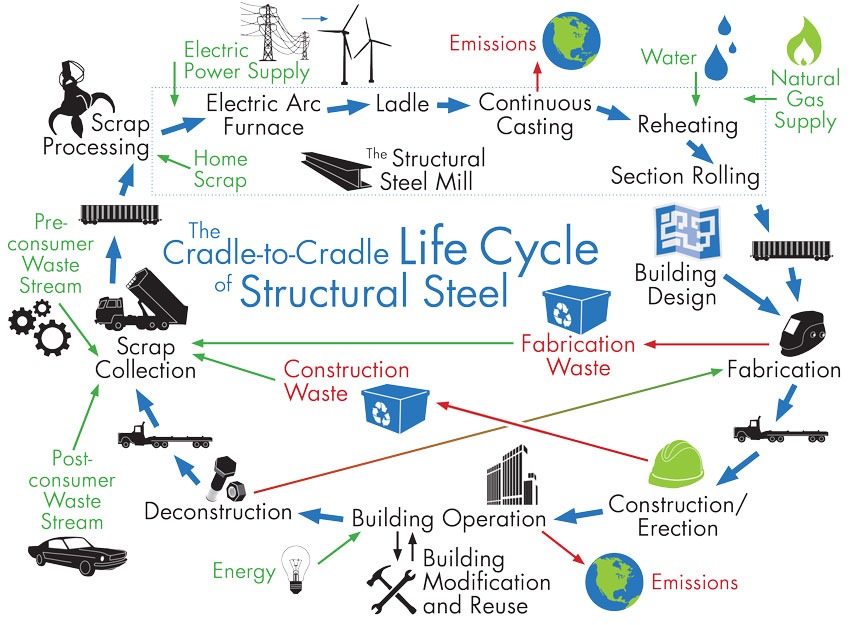There are no items in your cart
Add More
Add More
| Item Details | Price | ||
|---|---|---|---|
In the age of environmental consciousness, the construction industry is undergoing a paradigm shift towards sustainability, seeking innovative ways to minimize environmental impact, conserve resources, and enhance occupant well-being. Steel frame construction, with its inherent strength, versatility, and recyclability, offers a fertile ground for implementing sustainable design practices that pave the way for a greener future. In this comprehensive guide, we'll explore the principles, strategies, and benefits of sustainable design in steel frame construction, showcasing how architects, engineers, and builders can harness the power of steel to create buildings that are not only structurally sound but also environmentally responsible.
Sustainable design, also known as green design or eco-friendly design, is a holistic approach to building design and construction that seeks to minimize negative environmental impact while maximizing resource efficiency, energy efficiency, and occupant comfort. Sustainable design principles encompass various aspects of the building lifecycle, including site selection, material selection, energy consumption, water usage, and indoor environmental quality.

Implementing sustainable design practices in steel frame construction involves integrating environmental considerations into every stage of the design and construction process. Key strategies include:
1. Energy Efficiency:
Designing energy-efficient steel frame buildings involves optimizing building envelope performance, incorporating passive design strategies such as natural ventilation and daylighting, and integrating energy-efficient HVAC systems and lighting solutions. Energy modelling and analysis tools can help architects and engineers evaluate and optimize building energy performance.
2. Material Selection:
Choosing environmentally friendly materials with low embodied carbon footprint is essential for sustainable steel frame construction. Recycled steel content, locally sourced materials, and low-impact coatings can reduce environmental impact and contribute to LEED (Leadership in Energy and Environmental Design) certification.
3. Water Conservation:
Implementing water-efficient fixtures, rainwater harvesting systems, and graywater recycling technologies can help minimize water consumption in steel frame buildings. Sustainable landscape design practices, such as drought-tolerant landscaping and permeable paving, further reduce water usage and promote ecosystem health.
4. Indoor Environmental Quality:
indoor environmental quality (IEQ) involves creating healthy, comfortable, and productive indoor environments for building occupants. Sustainable design practices such as natural daylighting, non-toxic materials, low-emission finishes, and effective ventilation systems contribute to enhanced IEQ and occupant well-being.
The adoption of sustainable design practices in steel frame construction offers numerous benefits:
1. Environmental Preservation:
Sustainable steel frame construction helps mitigate environmental degradation, reduce carbon emissions, and conserve natural resources, contributing to a healthier planet and a more sustainable future.
2. Cost Savings:
While upfront costs for sustainable design features may be higher, the long-term benefits include reduced operating costs, energy savings, and increased asset value. Sustainable steel frame buildings also qualify for tax incentives, rebates, and certifications that further offset initial investment.
3. Enhanced Occupant Comfort and Health:
Sustainable steel frame buildings provide occupants with healthier, more comfortable indoor environments characterized by ample daylight, fresh air, and optimal thermal comfort. This contributes to improved productivity, satisfaction, and well-being among building occupants.
Sustainable design practices in steel frame construction represent a powerful means of addressing environmental challenges, promoting resource efficiency, and creating buildings that stand the test of time. By embracing principles of sustainability, architects, engineers, and builders can unlock the full potential of steel as a building material while minimising environmental impact and maximising social and economic benefits. As we strive towards a more sustainable built environment, the integration of sustainable design practices in steel frame construction stands as a beacon of hope, paving the way for a greener, healthier, and more resilient future.
{{30 July 2024}}
"Lorem Ipsum has been the industry's standard dummy text ever since the 1500s." — James Chapman
Lorem Ipsum is simply dummy text of the printing and typesetting industry. Lorem Ipsum has been the industry's standard dummy text ever since the 1500s, when an unknown printer took a galley of type and scrambled it to make a type specimen book. Lorem ipsum dolor amet, consectetur adipiscing elit.
Lorem Ipsum is simply dummy text of the printing and typesetting industry. Lorem Ipsum has been the industry's standard dummy text ever since the 1500s, when an unknown printer took a galley of type and scrambled it to make a type specimen book.

Niharika
A California-based travel writer, lover of food, oceans, and nature.